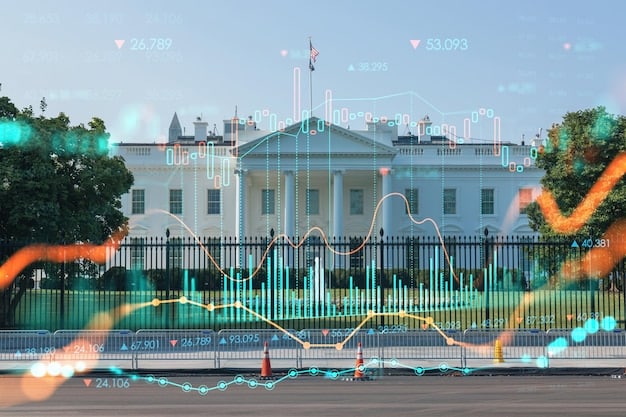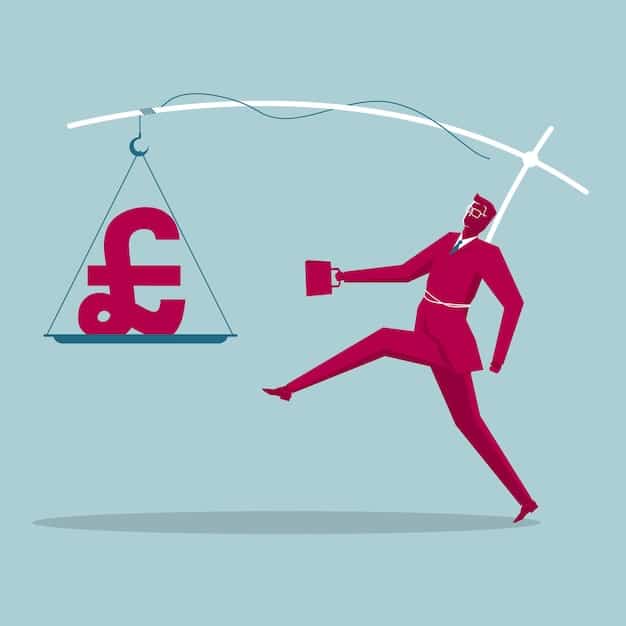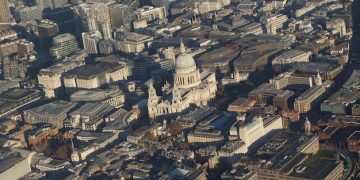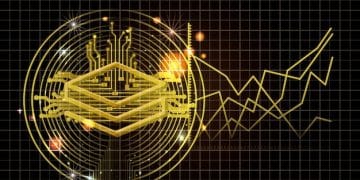Federal Reserve Rate Hike (0.75%) in 2025: Impact on US National Debt

The projected impact of the Federal Reserve’s anticipated 0.75% interest rate hike in early 2025 on the national debt involves increased borrowing costs, potentially slower economic growth, and a greater allocation of the federal budget towards interest payments, affecting the long-term fiscal outlook of the United States.
Understanding what is the projected impact of the Federal Reserve’s anticipated 0.75% interest rate hike in early 2025 on national debt is crucial for investors, policymakers, and the average citizen alike. As the Federal Reserve navigates economic challenges, its decisions ripple through the financial system, influencing everything from borrowing costs to economic growth.
Understanding the Federal Reserve’s Role in Monetary Policy
The Federal Reserve (often referred to as the Fed) is the central bank of the United States and plays a pivotal role in shaping the nation’s economy. Its primary tool is monetary policy, which includes adjusting interest rates to manage inflation and promote full employment. When the Fed raises interest rates, it aims to cool down an overheating economy or combat rising inflation. Conversely, lowering rates is intended to stimulate economic activity during periods of slowdown.
The Federal Funds Rate
The federal funds rate is the target rate that the Federal Reserve wants banks to charge one another for the overnight lending of reserves. This rate influences other interest rates throughout the economy, including those for mortgages, car loans, and business loans. Changes to this rate have far-reaching effects on consumer spending, investment decisions, and overall economic growth.
Understanding how the Federal Reserve operates and its impact on the economy provides a framework for analyzing the potential consequences of anticipated rate hikes. By keeping in mind the Fed’s objectives and the ripple effects of its policy decisions, we can better understand the projected impact of a specific rate increase on the national debt.

The National Debt: A Primer
The national debt represents the total amount of money that the U.S. federal government owes to its creditors. It accumulates over time through budget deficits, which occur when the government spends more money than it collects in revenue.
Components of the National Debt
The national debt consists of two main components: debt held by the public and intragovernmental holdings. Debt held by the public includes Treasury securities held by individuals, corporations, state and local governments, and foreign governments. Intragovernmental holdings represent debt owed by the government to its own agencies, such as Social Security trusts.
- Accumulated Deficits: The sum of all past budget deficits, representing the amount the government has borrowed to cover its spending.
- Impact on Future Generations: A larger national debt can place a burden on future generations through higher taxes or reduced government services.
- Investor Confidence: The level of national debt can impact investor confidence in the U.S. economy.
Managing the national debt is crucial for maintaining economic stability and ensuring the long-term fiscal health of the United States. Understanding its components and the factors that contribute to its growth is essential to assessing the impact of Federal Reserve policies on this critical aspect of the economy.
Analyzing the Impending 0.75% Rate Hike
A 0.75% interest rate hike is a significant move by the Federal Reserve, typically implemented to curb rising inflation. The anticipation of such a hike in early 2025 signals concerns about the pace of economic growth and the need to keep inflation in check. Before examining the effects on the national debt, it’s important to grasp the immediate implications of this policy adjustment.
Why a 0.75% Hike?
The decision to raise interest rates by 0.75% is not taken lightly. Factors such as persistently high inflation rates, strong labor market conditions, and overall economic activity play a role in the Fed’s decision-making process. The goal is to strike a balance between moderating inflation and avoiding a sharp economic downturn.
The Federal Reserve’s mandate is to promote maximum employment and price stability. With inflation rates above the Fed’s target, aggressive monetary policy actions, such as a 0.75% rate hike, are often deemed necessary. By increasing the cost of borrowing, the Fed hopes to reduce spending and investment, thereby easing demand-pull inflation.
- Economic Slowdown: Higher interest rates can slow down economic growth as businesses and consumers reduce borrowing and spending.
- Inflation Control: The primary aim is to bring down inflation by reducing demand in the economy.
- Fiscal Stability: While designed to manage inflation, the rate hike can have significant implications for government borrowing and the national debt.
The rate hike can impact various sectors, including housing, automotive, and manufacturing, as borrowing becomes more expensive. Ultimately, the effectiveness of the policy in achieving its goals will depend on various factors, including the responsiveness of consumers and businesses to the change in interest rates.
The Immediate Impact on Borrowing Costs
One of the most direct effects of a Federal Reserve interest rate hike is an increase in borrowing costs throughout the economy. This impacts government borrowing as well, particularly concerning the national debt.
Higher Interest Payments
When the Federal Reserve raises interest rates, the cost of issuing new debt increases for the government. As existing Treasury securities mature and new ones are issued to replace them, the government must pay higher interest rates to attract investors. This leads to an increase in the total interest expense on the national debt.
The US Treasury issues various types of securities, including Treasury bills, notes, and bonds, to finance government operations. A 0.75% rate hike can significantly raise the yield on these securities, translating into higher borrowing costs for the government. The impact is more pronounced with short-term debt, which needs to be refinanced more frequently.
The higher borrowing costs associated with a 0.75% rate hike would necessitate a larger allocation of the federal budget towards interest payments, potentially squeezing out other government programs or requiring additional borrowing, further exacerbating the national debt situation.

Long-Term Effects on the National Debt
Beyond the immediate increase in borrowing costs, a Federal Reserve interest rate hike can have long-term effects on the national debt, influencing its trajectory and sustainability.
Economic Growth Implications
Slower economic growth induced by the rate hike can lead to reduced tax revenues for the government. As businesses and consumers cut back on spending and investment, economic activity decelerates, resulting in lower income and sales tax collections. This can widen budget deficits and further contribute to the accumulation of national debt.
The interplay between interest rates, economic growth, and national debt is complex. Higher interest rates can dampen economic activity, leading to lower tax revenues. Meanwhile, the increased cost of servicing the debt puts additional pressure on the budget. Without compensatory measures, such as fiscal adjustments or productivity gains, the debt burden could become unsustainable in the long run.
Fiscal Policy Responses
The government’s fiscal policy responses to a rate hike are crucial in determining the long-term effects on the national debt. If the government implements measures to reduce spending or increase revenues, it can mitigate the impact of higher interest expenses. However, if fiscal policy remains unchanged or becomes more expansionary, the national debt could spiral further.
Potential Mitigation Strategies and Economic Outlook
Addressing the projected impact of a Federal Reserve rate hike on the national debt requires a multi-faceted approach. Fiscal prudence, economic reforms, and proactive debt management strategies are crucial to navigate the challenges effectively.
Fiscal Prudence Measures
Implementing fiscal prudence measures involves reducing government spending, increasing tax revenues, or a combination of both. This could include streamlining government programs, eliminating wasteful spending, and implementing tax reforms to broaden the tax base and increase revenue collection. Fiscal discipline is essential to prevent the national debt from escalating further.
Boosting economic growth through supply-side policies, such as deregulation, infrastructure investments, and tax incentives for businesses, can generate higher tax revenues and alleviate the burden on the national debt. By fostering a more vibrant and productive economy, the government can improve its fiscal outlook and reduce its reliance on borrowing.
- Debt Refinancing: Extending the maturity profile of the national debt can reduce the government’s exposure to interest rate fluctuations.
- Inflation Targeting: Maintaining a credible commitment to price stability can anchor inflation expectations.
- Budget Prioritization: Reallocating resources to high-return investments, such as education, research, and infrastructure.
The effectiveness of these strategies in mitigating the impact of a Federal Reserve rate hike on the national debt will depend on their timely implementation and coordination with monetary policy. It’s vital for policymakers to adopt a holistic approach that considers the interplay between fiscal, monetary, and structural policies to ensure the long-term fiscal sustainability of the United States while maintaining economic stability
| Key Point | Brief Description |
|---|---|
| 💰 Increased Borrowing Costs | Federal rate hikes raise the cost for the government to issue new debt. |
| 📉 Slower Economic Growth | Higher rates can lead to reduced investment and slower economic expansion. |
| 💸 Higher Interest Payments | A larger portion of the budget is allocated to interest payments on national debt. |
| 📈 Fiscal Policy Responses | Government actions to manage spending, taxes, and debt are crucial. |
Frequently Asked Questions
▼
The Federal Reserve raises interest rates primarily to combat inflation. When inflation is high, increasing interest rates helps to slow down economic activity by making borrowing more expensive, thereby reducing spending and investment.
▼
A rate hike increases the cost of borrowing for the government. As older debts mature and new ones are issued, the government must pay higher interest rates, leading to a larger portion of the budget being allocated to interest payments.
▼
The federal funds rate is the target interest rate set by the Federal Reserve for the overnight lending of reserves between banks. It influences other interest rates throughout the economy, affecting consumer and business borrowing costs.
▼
The government can implement fiscal prudence measures, such as reducing spending and increasing tax revenue. Additionally, promoting economic growth through strategic investments and efficient debt management can help alleviate the burden.
▼
The long-term outlook depends heavily on the government’s fiscal and monetary policy responses. If prudent measures are taken to manage spending, boost economic growth, and stabilize interest rates, the debt can be managed effectively. Otherwise, it will keep growing.
Conclusion
In summary, the Federal Reserve’s anticipated 0.75% interest rate hike in early 2025 poses significant implications for the national debt, impacting borrowing costs, economic growth, and fiscal policy. Effective strategies and balanced fiscal management are essential to navigate these challenges to secure long-term economic stability.





